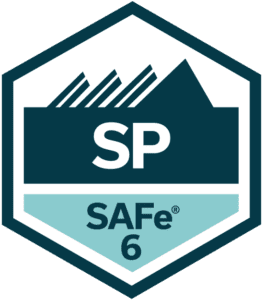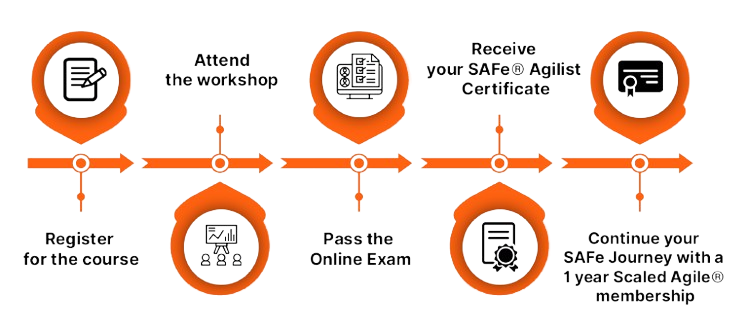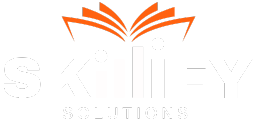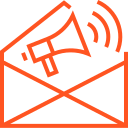- Home
- »
- SAFe® for Teams Certification Course
 SAFe® Certification Course
SAFe® Certification Course
SAFe® for Teams Certification Course
What’s included:
- Course workbook and SAFe® Studio access to help prepare you to take the certification exam, claim their digital badge, and tools to get started in your SAFe role.
- One-year access to SAFe® Studio with your first class attendance.
- Access to the latest Framework guidance.
- Member discussion forums to engage in ongoing conversations on the SAFe Framework or how to better perform as part of an Agile Team.
- Curated content-playlists based on your interests and roles, including templated resources and facilitation guides to get you started.
- Access to content, tools, and resources you need to practice SAFe every day.
- SAFe® 6.0 Practitioner certification exam.
Overview
Earn your SAFe® Practitioner Certification and establish team agility
What does it mean to be part of an Agile team on an Agile Release Train (ART) that delivers value to customers? SAFe® for Teams covers the tactical skills to be a high-performing member of an ART. The course also gives you the guidance and tools to work effectively in remote environments with distributed teams. Get the most out of your learning experience by taking it in context with your team and other teams on your ART.
SAFe for Teams will teach you how to plan and execute work, how to apply Scaled Agile Framework® and Agile principles, and how to continuously improve. Taking Scaled Agile Framework® for Teams gives your team the collective knowledge to collaborate effectively, do the best possible work, and hit the ground running before your next planning event.
Exam Details
SAFe® for Teams Certification Course – Prerequisites:
Attendees are required to possess a basic grasp of Agile best practices and methods and to have taken at least one SAFe® course prior to registering in this program.
- 90 minutes Online closed book Exam.
- 45 Questions of Multiple-Choice, Single Select format.
- 71% Passing Score.
- Exam gets submitted when timer goes out.
- Unanswered questions to be considered Wrong.
Career Path: SAFe® Architect
As demand for Enterprise, System, and Solution Architects is increasing, obtaining a SAFe® Architect certification offers a significant career boost. This certification enables professionals to align Agile architecture with business goals, ensuring seamless collaboration and scalable growth within organizations.
Advanced Certifications to Consider
To further enhance expertise, professionals can pursue:
- SAFe® Advanced Scrum Master (SSM) – Master facilitation and Agile leadership
- SAFe® Practice Consultant (SPC) – Enterprise Agile transformation coaching
- SAFe® Release Train Engineer (RTE) – Managing Agile Release Trains
- SAFe® DevOps Practitioner (SDP) – Applying DevOps to Agile environments
- SAFe® Lean Portfolio Manager (LPM) – Strategic portfolio alignment
Potential Career Paths
Depending on skills and interests, professionals can explore roles such as:
- Solution Architect – Design and implement scalable Agile solutions
- Enterprise Architect – Align technology and business strategies for agility
- System Architect – Design systems for Agile delivery
- Release Train Engineer (RTE) – Manage Agile Release Trains for large-scale delivery
Next Steps
Advance your career by obtaining SAFe® Architect training, gaining hands-on experience, and actively engaging with Agile communities.

Get Certified
Steps to Getting Certified
1. Enroll yourself in our SAFe® for Teams Certification Course
2. Attend the two-day training session
3. Await the Exam Information from Scaled Agile
4. Accept the Candidate Agreement and take your exam
5. Score a minimum of 71% and pass the test
6. Get Certified as SAFe® for Teams Certification Course 6.0 from Scaled Agile
SAFe® for Teams Certification Course Training Calendar
Attendees learn:

How to realize the benefits of SAFe, including:

Your role on the team and your team’s role on the ART
Your role on the team and your team’s role on the ART
Your role on the team and your team’s role on the ART

How to apply SAFe principles to scale Lean-Agile delivery
How to apply SAFe principles to scale Lean-Agile delivery
How to apply SAFe principles to scale Lean-Agile delivery

How to plan and execute iterations and PIs
How to plan and execute iterations and PIs
How to plan and execute iterations and PIs
And How to continuously improve the ART
Free Consultation



 Overview
Overview Exam Detail
Exam Detail Career Path
Career Path